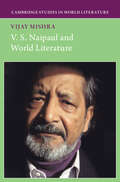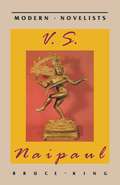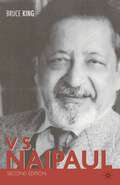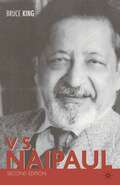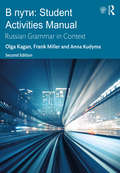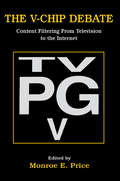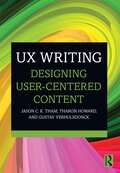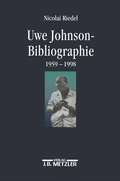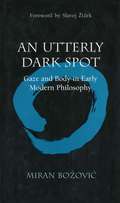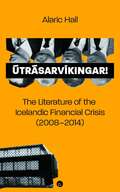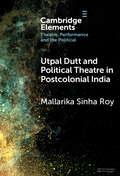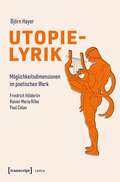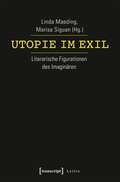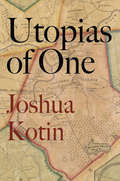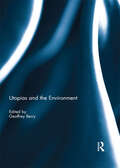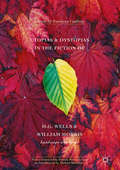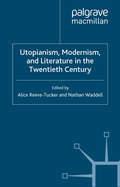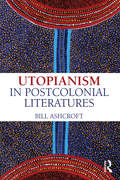- Table View
- List View
V. S. Naipaul and World Literature (Cambridge Studies in World Literature)
by null Vijay MishraV. S. Naipaul is a major and controversial figure in postcolonial and world literature. This book provides a challenging and uncompromisingly honest study that engages with history, genre theory, aesthetics, and global literary culture, with close reference to Naipaul's published and archival material. In his fiction and creative histories, the definition of the modern idea of world literature is informed by the importance of an artistic ordering of perception. Although often expressing ideas that are prejudicial and morally repugnant, there is an honesty in his writings where one finds extraordinary insights into how life is experienced within colonial structures of power. These colonial structures provided no abstract unity to the field of literary expression and ignored vernacular cultures. The book argues that a universal ideology of the aesthetic, transcending time, regions, and languages, provides world literature with a unity which is possible only within a critical universal humanism attuned to heroic readings of texts and cultures.
V. S. Naipaul (Modern Novelists)
by Bruce KingThis is a user-friendly introduction to the novels and the non-fiction of V.S. Naipaul that will be of interest both to the student and to the specialist. It examines the language, structure, themes and development of Naipaul's writing, setting the novels in their autobiographical, philosophical, social and political, colonial and post-colonial contexts. Attention is given to Naipaul's existentialism, relationship to his literary models, use of Indian philosophy and vision of the Indian diaspora. Naipaul is shown to use similar formal literary structures and to have recurring themes and preoccupations during the four distinctive periods of his writing.
V.S. Naipaul
by Bruce KingV. S. Naipaul is a reader-friendly introduction to the writing of one of the most influential contemporary authors and the 2001 Nobel laureate in Literature. Bruce King provides a novel by novel analysis of the fiction with attention to structure, significance, and Naipaul's development as a writer, while setting the texts in their autobiographical. philosophical, social, political, colonial and postcolonial contexts. King shows how Naipaul modified Western and Indian literary traditions for the West Indies and then the wider world to become an international writer whose subject matter includes the Caribbean, England, India, Africa, the United States, Argentina, and contemporary Islam.Thoroughly revised and updated, the second edition of V. S. Naipaul now includes an expanded Introduction, and discussion of his most recent novels A Way in the World and Half a Life, his Nobel Lecture, Naipaul's writings on Islam, and a survey of the main criticism by other writers and postcolonial theorists.
V.S. Naipaul
by Bruce KingV. S. Naipaul is a reader-friendly introduction to the writing of one of the most influential contemporary authors and the 2001 Nobel laureate in Literature. Bruce King provides a novel by novel analysis of the fiction with attention to structure, significance, and Naipaul's development as a writer, while setting the texts in their autobiographical. philosophical, social, political, colonial and postcolonial contexts. King shows how Naipaul modified Western and Indian literary traditions for the West Indies and then the wider world to become an international writer whose subject matter includes the Caribbean, England, India, Africa, the United States, Argentina, and contemporary Islam.Thoroughly revised and updated, the second edition of V. S. Naipaul now includes an expanded Introduction, and discussion of his most recent novels A Way in the World and Half a Life, his Nobel Lecture, Naipaul's writings on Islam, and a survey of the main criticism by other writers and postcolonial theorists.
V Puti: Russian Grammar in Context
by Frank Miller Olga Kagan Anna KudymaThis highly successful program assists in the development of all the language skills (listening, speaking, reading and writing) by presenting realistic settings, situations and contexts. It consists of 12 chapters and can be used in an intermediate or advanced Russian course. V Puti offers conversational exercises, various readings (biographies, poems, literature and historical texts) and grammatical explanations and practice. All of these components reinforce Russian culture and history which enable the students to understand the Russian language in context. V Puti: Student Activities Manual is an integral part of the V Puti course. The structure matches the main textbook and provides a wealth of exercises and activities, either for class-use or homework.
V Puti: Russian Grammar in Context
by Frank Miller Olga Kagan Anna KudymaThis highly successful program assists in the development of all the language skills (listening, speaking, reading and writing) by presenting realistic settings, situations and contexts. It consists of 12 chapters and can be used in an intermediate or advanced Russian course. V Puti offers conversational exercises, various readings (biographies, poems, literature and historical texts) and grammatical explanations and practice. All of these components reinforce Russian culture and history which enable the students to understand the Russian language in context. V Puti: Student Activities Manual is an integral part of the V Puti course. The structure matches the main textbook and provides a wealth of exercises and activities, either for class-use or homework.
The V-chip Debate: Content Filtering From Television To the Internet (Routledge Communication Series)
by Monroe E. PriceThe V-chip is a highly significant part of the discussion about whether television (or broadcasting in general) deserves some special attention in terms of its accessibility to children, its particular power to affect conduct, and its invasiveness. But as this notion of filtering and labeling has caught the imagination of the regulator, the legislator, and all those who wish to consider new ways to alter bargaining over imagery in society, the very idea of the V-chip or its equivalent is moving across other technologies, including the Internet. The V-chip issue has also fueled the ongoing debate about violence and sexual practices in society, and how representations on television relate to those practices. Although the initial concept of the V-chip is simple, its flow into the public realm raises so many extraordinary questions that the introduction and production of the chip virtually serves as a case study in problems of law and public policy. The very conceptualization of speech in society is being affected by this issue. Accordingly, the place of the V-chip in this debate is increasingly important; indeed, it may be argued that the V-chip's contribution to legal argumentation may be greater than its ultimate contribution to the relationship between children and imagery. Among the questions the contributors address are: *What research basis is necessary to require a framework for labeling and rating? *What relationship between government and the image-producing industries can be characterized--for constitutional and other reasons--as voluntary as opposed to coercive? *Who should evaluate these images? *To what extent should the evaluation process be centralized and/or distributed? *What assessment is appropriate to evaluate whether the experiment is "successful?" In addition to the V-chip's origin's in Canada and its further evolution in the United States, this book discusses the development of the V-chip and television rating systems in Europe, Australia, and throughout the world. It also includes essays which contrast the very different approaches in Canada and the United States in terms of the role of regulatory agency, industry, and government.
The V-chip Debate: Content Filtering From Television To the Internet (Routledge Communication Series)
by Monroe E. PriceThe V-chip is a highly significant part of the discussion about whether television (or broadcasting in general) deserves some special attention in terms of its accessibility to children, its particular power to affect conduct, and its invasiveness. But as this notion of filtering and labeling has caught the imagination of the regulator, the legislator, and all those who wish to consider new ways to alter bargaining over imagery in society, the very idea of the V-chip or its equivalent is moving across other technologies, including the Internet. The V-chip issue has also fueled the ongoing debate about violence and sexual practices in society, and how representations on television relate to those practices. Although the initial concept of the V-chip is simple, its flow into the public realm raises so many extraordinary questions that the introduction and production of the chip virtually serves as a case study in problems of law and public policy. The very conceptualization of speech in society is being affected by this issue. Accordingly, the place of the V-chip in this debate is increasingly important; indeed, it may be argued that the V-chip's contribution to legal argumentation may be greater than its ultimate contribution to the relationship between children and imagery. Among the questions the contributors address are: *What research basis is necessary to require a framework for labeling and rating? *What relationship between government and the image-producing industries can be characterized--for constitutional and other reasons--as voluntary as opposed to coercive? *Who should evaluate these images? *To what extent should the evaluation process be centralized and/or distributed? *What assessment is appropriate to evaluate whether the experiment is "successful?" In addition to the V-chip's origin's in Canada and its further evolution in the United States, this book discusses the development of the V-chip and television rating systems in Europe, Australia, and throughout the world. It also includes essays which contrast the very different approaches in Canada and the United States in terms of the role of regulatory agency, industry, and government.
UX Writing: Designing User-Centered Content
by Jason C.K. Tham Tharon Howard Gustav VerhulsdonckThis flexible textbook provides an integrated approach to user experience (UX) writing and equips students and practitioners with the essential principles and methods to succeed in writing for UX. The fundamental goal of UX writing is to produce usable and attractive content that boosts user engagement and business growth. This book teaches writers how to create content that helps users perform desired tasks while serving business needs. It is informed by user-centered design, content strategy, artificial intelligence (AI), and digital marketing communication methodologies, along with UX-related practices. By combining writing-as-design and design-as-writing, the book offers a new perspective for technical communication education where UX design and writing are merged to achieve effective and desirable outcomes. Outlining the key principles and theories for writing user-centered content design, this core textbook is fundamental reading for students and early career practitioners in UX, technical communication, digital marketing, and other areas of professional writing.
UX Writing: Designing User-Centered Content
by Jason C.K. Tham Tharon Howard Gustav VerhulsdonckThis flexible textbook provides an integrated approach to user experience (UX) writing and equips students and practitioners with the essential principles and methods to succeed in writing for UX. The fundamental goal of UX writing is to produce usable and attractive content that boosts user engagement and business growth. This book teaches writers how to create content that helps users perform desired tasks while serving business needs. It is informed by user-centered design, content strategy, artificial intelligence (AI), and digital marketing communication methodologies, along with UX-related practices. By combining writing-as-design and design-as-writing, the book offers a new perspective for technical communication education where UX design and writing are merged to achieve effective and desirable outcomes. Outlining the key principles and theories for writing user-centered content design, this core textbook is fundamental reading for students and early career practitioners in UX, technical communication, digital marketing, and other areas of professional writing.
UX on the Go: A Flexible Guide to User Experience Design
by Andrew MaraDesigned with flexibility and readers’ needs in mind, this purpose driven book offers new UX practitioners succinct and complete intructions on how to conduct user research and rapidly design interfaces and products in the classroom or the office. With 16 challenges to learn from, this comprehensive guide outlines the process of a User Experience project cycle from assembling a team to researching user needs to creating and veryifying a prototype. Practice developing a prototype in as little as a week or build your skills in two-, four-, eight-, or sixteen-week stretches. Gain insight into individual motivations, connections, and interactions; learn the three guiding principles of the design system; and discover how to shape a user’s experience to achieve goals and improve overall immediate experience, satisfaction, and well-being. Written for professionals looking to learn or expand their skills in user experience design and students studying technical communication, information technology, web and product design, business, or engingeering alike, this accessible book provides a foundational knowledge of this diverse and evolving field. A companion website will include examples of contemporary UX projects, material to illustrate key techniques, and other resources for students and instructors. Access the material at uxonthego.com.
UX on the Go: A Flexible Guide to User Experience Design
by Andrew MaraDesigned with flexibility and readers’ needs in mind, this purpose driven book offers new UX practitioners succinct and complete intructions on how to conduct user research and rapidly design interfaces and products in the classroom or the office. With 16 challenges to learn from, this comprehensive guide outlines the process of a User Experience project cycle from assembling a team to researching user needs to creating and veryifying a prototype. Practice developing a prototype in as little as a week or build your skills in two-, four-, eight-, or sixteen-week stretches. Gain insight into individual motivations, connections, and interactions; learn the three guiding principles of the design system; and discover how to shape a user’s experience to achieve goals and improve overall immediate experience, satisfaction, and well-being. Written for professionals looking to learn or expand their skills in user experience design and students studying technical communication, information technology, web and product design, business, or engingeering alike, this accessible book provides a foundational knowledge of this diverse and evolving field. A companion website will include examples of contemporary UX projects, material to illustrate key techniques, and other resources for students and instructors. Access the material at uxonthego.com.
Uwe Johnson-Bibliographie 1959-1998
by Nicolai Riedel"Dichter der beiden Deutschland". Die Bibliographie von Nicolai Riedel dokumentiert in systematisch-chronologischer Ordnung die internationale Wirkungsgeschichte Uwe Johnsons. Der Band zieht die Bilanz einer vierzigjährigen publizistischen und wissenschaftlichen Rezeptionsgeschichte. Mit rund 4.000 Einträgen zeigt er ausführlich das Werk des Autors der deutschen Teilung.
An Utterly Dark Spot: Gaze and Body in Early Modern Philosophy (The Body, In Theory: Histories of Cultural Materialism)
by Miran BozovicSlovenian philosopher Miran Bozovic's An Utterly Dark Spot examines the elusive status of the body in early modern European philosophy by examining its various encounters with the gaze. Its range is impressive, moving from the Greek philosophers and theorists of the body (Aristotle, Plato, Hippocratic medical writers) to early modern thinkers (Spinoza, Leibniz, Malebranche, Descartes, Bentham) to modern figures including Jon Elster, Lacan, Althusser, Alfred Hitchcock, Stephen J. Gould, and others. Bozovic provides startling glimpses into various foreign mentalities haunted by problems of divinity, immortality, creation, nature, and desire, provoking insights that invert familiar assumptions about the relationship between mind and body. The perspective is Lacanian, but Bozovic explores the idiosyncrasies of his material (e.g., the bodies of the Scythians, the transvestites transformed and disguised for the gaze of God; or Adam's body, which remained unseen as long as it was the only one in existence) with an attention to detail that is exceptional among Lacanian theorists. The approach makes for engaging reading, as Bozovic stages imagined encounters between leading thinkers, allowing them to converse about subjects that each explored, but in a different time and place. While its focus is on a particular problem in the history of philosophy, An Utterly Dark Spot will appeal to those interested in cultural studies, semiotics, theology, the history of religion, and political philosophy as well. Miran Bozovic is Associate Professor of Philosophy at the University of Ljubljana, Slovenia. He is the author of Der grosse Andere: Gotteskonzepte in der Philosophie der Neuzeit (Vienna: Verlag Turia & Kant, 1993) and editor of The Panopticon Writings by Jeremy Bentham (London: Verso, 1995).
Útrásarvíkingar! The Literature of the Icelandic Financial Crisis (2008–2014): The Literature Of The Icelandic Financial Crisis (2008-2014)
by Alaric HallAs the global banking boom of the early twenty-first century expanded towards implosion, Icelandic media began calling the country’s celebrity financiers útrásarvíkingar: “raiding vikings.” This new coinage encapsulated the macho, medievalist nationalism which underwrote Iceland’s exponential financialisation. Yet within a few days in October 2008, Iceland saw all its main banks collapse beneath debts worth nearly ten times the country’s GDP.Hall charts how Icelandic novelists and poets grappled with the Crash over the ensuing decade. As the first English-language monograph devoted to twenty-first-century Icelandic literature, it provides Anglophone readers with an introduction to one of the world’s liveliest literary scenes. It also contributes a key case study for understanding global artistic responses to the early twenty-first century crisis of runaway, unregulated capitalism, exploring the struggles of writers to adapt realist forms of art to surreal times.As Iceland’s biggest crisis since their independence from Denmark in 1944, the effect of the Crash on the national self-image was as seismic as its effects on the economy. This study analyses the centrality of whiteness and the abjection of the “developing world” in Iceland’s post-colonial identity, and shows how Crash-writing explores the collisions of Iceland’s traditional, nationalist medievalism with a dystopian, Orientalist medievalism associated with the Islamic world.The Crash in Iceland was instantly recognised as offering important economic insights. This book shows how Iceland also helps us to understand the cultural convulsions that have followed the Financial Crisis widely in the West.
Utpal Dutt and Political Theatre in Postcolonial India (Elements in Theatre, Performance and the Political)
by null Mallarika Sinha RoyAmong the most significant playwrights and theatre-makers of postcolonial India, Utpal Dutt (1929–1993), was an early exponent of rethinking colonial history through political theatre. Dutt envisaged political theatre as part of the larger Marxist project, and his incorporation of new developments in Marxist thinking, including the contributions of Antonio Gramsci, makes it possible to conceptualise his protagonists as insurgent subalterns. A decolonial approach to staging history remained a significant element in Dutt's artistic project. This Element examines Dutt's passionate engagement with Marxism and explores how this sense of urgency was actioned through the writing and producing of plays about the peasant revolts and armed anti-colonial movements which took place during the period of British rule. Drawing on contemporary debates in political theatre regarding the autonomy of the spectator and the performance of history, the author locates Dutt's political theatre in a historical frame.
Utopielyrik: Möglichkeitsdimensionen im poetischen Werk. Friedrich Hölderlin - Rainer Maria Rilke - Paul Celan (Lettre)
by Björn HayerWährend utopische Romane zum Kanon der Literatur(-wissenschaft) gehören, steht utopische Lyrik selten im Fokus. Wie Björn Hayer zeigt, ist eine neue Lesart der poetischen Werke von Friedrich Hölderlin, Rainer Maria Rilke und Paul Celan, denen man bislang nicht unbedingt eine optimistische Sicht auf die Moderne bescheinigt hat, im Lichte der Zukunftsgerichtetheit lohnenswert: Zum einen werden darin politische und kulturelle Visionen ersichtlich, die vom Traum einer egalitären Gesellschaft bis hin zu einer die Grenze des Jenseits überschreitenden Erinnerungskultur reichen. Zum anderen fördert die Untersuchung sprachästhetische Entwürfe zutage, die unmittelbar an die Dynamik der Utopie als Denkprozess gekoppelt sind.
Utopie im Exil: Literarische Figurationen des Imaginären (Lettre)
by Linda Maeding Marisa SiguanDie Forschung betrachtet Flucht- und Exilerfahrungen noch immer vornehmlich mit Bezug auf die Vergangenheit. Doch ein bedeutender Teil der Exilliteratur wird von Diskursen des Zukünftigen und - in potenzierter Form - des Utopischen begleitet. Dieses utopische Potenzial des Exils wurde bisher nicht systematisch aufgearbeitet. Die Beiträge aus der Germanistik und anderen Philologien untersuchen u.a., welche Zeiten und Räume sich das Utopische im Exil aneignet. Sie gehen den zahlreichen Beispielen für Nicht-Orte in der Exilliteratur nach und zeigen, dass sich in der Erfahrung der Krise häufig Utopie und Dystopie überschneiden.
Utopias of One
by Joshua KotinUtopias fail. Utopias of one do not. They are perfect worlds. Yet their success comes at a cost. They are radically singular—and thus exclusive and inimitable.Utopias of One is a major new account of utopian writing. Joshua Kotin examines how eight writers—Henry David Thoreau, W. E. B. Du Bois, Osip and Nadezhda Mandel’shtam, Anna Akhmatova, Wallace Stevens, Ezra Pound, and J. H. Prynne—construct utopias of one within and against modernity’s two large-scale attempts to harmonize individual and collective interests: liberalism and communism. The book begins in the United States between the buildup to the Civil War and the end of Jim Crow; continues in the Soviet Union between Stalinism and the late Soviet period; and concludes in England and the United States between World War I and the end of the Cold War. The book, in this way, captures how writers from disparate geopolitical contexts resist state and normative power to construct perfect worlds—for themselves alone.Utopias of One makes a vital contribution to debates about literature and politics, presenting innovative arguments about aesthetic difficulty, personal autonomy, and complicity and dissent. The book also models a new approach to transnational and comparative scholarship, combining original research in English and Russian to illuminate more than a century and a half of literary and political history.
Utopias of One
by Joshua KotinUtopias fail. Utopias of one do not. They are perfect worlds. Yet their success comes at a cost. They are radically singular—and thus exclusive and inimitable.Utopias of One is a major new account of utopian writing. Joshua Kotin examines how eight writers—Henry David Thoreau, W. E. B. Du Bois, Osip and Nadezhda Mandel’shtam, Anna Akhmatova, Wallace Stevens, Ezra Pound, and J. H. Prynne—construct utopias of one within and against modernity’s two large-scale attempts to harmonize individual and collective interests: liberalism and communism. The book begins in the United States between the buildup to the Civil War and the end of Jim Crow; continues in the Soviet Union between Stalinism and the late Soviet period; and concludes in England and the United States between World War I and the end of the Cold War. The book, in this way, captures how writers from disparate geopolitical contexts resist state and normative power to construct perfect worlds—for themselves alone.Utopias of One makes a vital contribution to debates about literature and politics, presenting innovative arguments about aesthetic difficulty, personal autonomy, and complicity and dissent. The book also models a new approach to transnational and comparative scholarship, combining original research in English and Russian to illuminate more than a century and a half of literary and political history.
Utopias and the Environment
by Geoffrey BerryUtopias and the Environment explores the way in which the kind of ‘dreaming’, or re-visioning, known as the ‘utopian imaginary’ takes environmental concerns into account. This kind of creative intervention is increasingly important in an era of ecological crisis, as we witness the failure of governments worldwide to significantly change industrial civilization from a path of ‘business as usual.’ In this context, it is up to the artists – in this case authors – to imagine new ways of being that respond to this imperative and immediate global issue. Concurrently, it is also up to critics, readers, and thinkers everywhere to appraise these narratives of possibility for their complexities and internal conflicts, as well as for their promise, as we enter this new era of rapid change and adaptation. Because creative and critical thinkers must work together towards this goal, the idea of the critical utopia, coined by Tom Moylan in response to the fiction of the 1970s, is now ingrained in the common argot and is one of the key ideas discussed in this book. This development in the genre, which combines self-reflexivity and multiple perspectives within its dreaming, represents the postmodern spirit in its most regenerative aspect. This book is testament to such hopes and potential realities. This book was originally published as a special issue of Green Letters.
Utopias and the Environment
by Geoffrey BerryUtopias and the Environment explores the way in which the kind of ‘dreaming’, or re-visioning, known as the ‘utopian imaginary’ takes environmental concerns into account. This kind of creative intervention is increasingly important in an era of ecological crisis, as we witness the failure of governments worldwide to significantly change industrial civilization from a path of ‘business as usual.’ In this context, it is up to the artists – in this case authors – to imagine new ways of being that respond to this imperative and immediate global issue. Concurrently, it is also up to critics, readers, and thinkers everywhere to appraise these narratives of possibility for their complexities and internal conflicts, as well as for their promise, as we enter this new era of rapid change and adaptation. Because creative and critical thinkers must work together towards this goal, the idea of the critical utopia, coined by Tom Moylan in response to the fiction of the 1970s, is now ingrained in the common argot and is one of the key ideas discussed in this book. This development in the genre, which combines self-reflexivity and multiple perspectives within its dreaming, represents the postmodern spirit in its most regenerative aspect. This book is testament to such hopes and potential realities. This book was originally published as a special issue of Green Letters.
Utopias and Dystopias in the Fiction of H. G. Wells and William Morris: Landscape and Space
by Emelyne GodfreyThis book is about the fiercely contrasting visions of two of the nineteenth century’s greatest utopian writers. A wide-ranging, interdisciplinary study, it emphasizes that space is a key factor in utopian fiction, often a barometer of mankind’s successful relationship with nature, or an indicator of danger. Emerging and critically acclaimed scholars consider the legacy of two great utopian writers, exploring their use of space and time in the creation of sites in which contemporary social concerns are investigated and reordered. A variety of locations is featured, including Morris’s quasi-fourteenth century London, the lush and corrupted island, a routed and massacred English countryside, the high-rises of the future and the vertiginous landscape of another Earth beyond the stars.
Utopianism, Modernism, and Literature in the Twentieth Century
by Alice Reeve-Tucker and Nathan WaddellUtopianism, Modernism, and Literature in the Twentieth Century considers the links between utopianism and modernism in two ways: as an under-theorized nexus of aesthetic and political interactions; and as a sphere of confluences that challenges accepted critical models of modernist and twentieth-century literary history. An international group of scholars considers works by E. M. Forster, Ford Madox Ford, Wyndham Lewis, Naomi Mitchison, Katharine Burdekin, Rex Warner, Yevgeny Zamyatin, Thomas Pynchon, Elizabeth Bowen, James Baldwin, Toni Morrison, and Ernst Bloch. In doing so, this volume's contributors prompt new reflections on key aspects of utopianism in experimental twentieth-century literature and non-fictional writing; deepen literary-historical understandings of modernism's socio-political implications; and bear out the on-going relevance of modernism's explorations of utopian thought. Utopianism, Modernism, and Literature in the Twentieth Century will appeal to anyone with an interest in how deeply and how differently modernist writers, as well as writers influenced by or resistant to modernist styles, engaged with issues of utopianism, perfectibility, and social betterment.
Utopianism in Postcolonial Literatures
by Bill AshcroftPostcolonial Studies is more often found looking back at the past, but in this brand new book, Bill Ashcroft looks to the future and the irrepressible demands of utopia. The concept of utopia – whether playful satire or a serious proposal for an ideal community – is examined in relation to the postcolonial and the communities with which it engages. Studying a very broad range of literature, poetry and art, with chapters focussing on specific regions – Africa, India, Chicano, Caribbean and Pacific – this book is written in a clear and engaging prose which make it accessible to undergraduates as well as academics. This important book speaks to the past and future of postcolonial scholarship.
